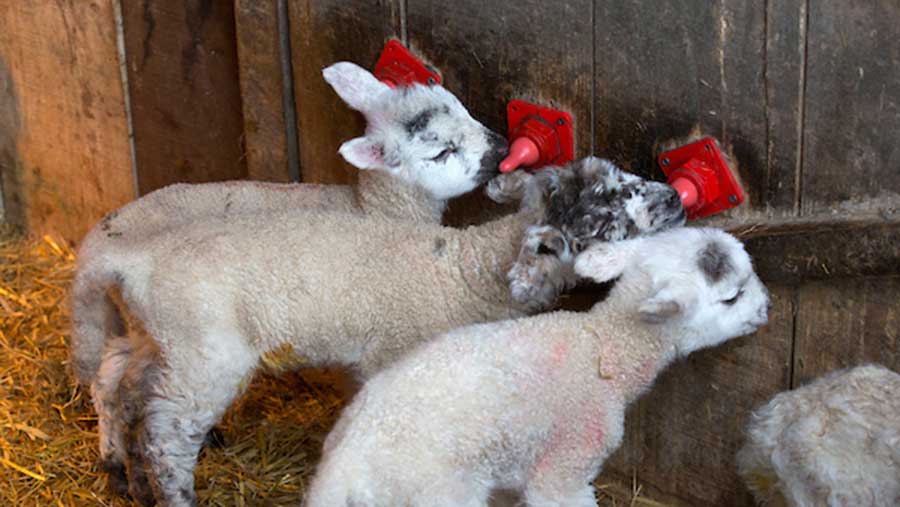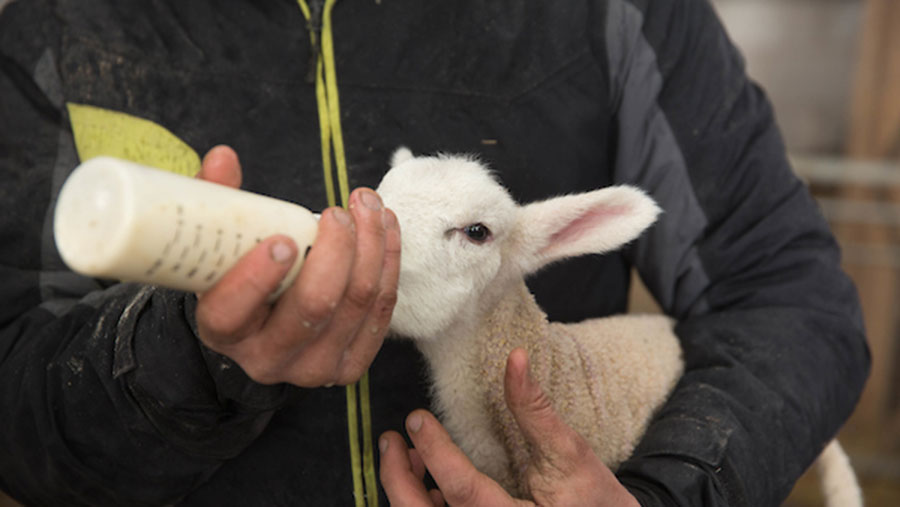8 key steps to successful surplus lamb management
 © Tim Scrivener
© Tim Scrivener While no sheep farmer particularly wants to end up with surplus lambs, which have a particularly bad reputation, when reared well they can provide a decent margin.
A recent trial carried out at the Institute of Biological, Environmental & Rural Sciences (IBERS) at Aberystwyth University showed that there was no difference in the performance of surplus lambs reared on performance-formulated lamb milk replacer (based on whey protein from cows’ milk), compared with those left on the ewe.
“Introducing surplus lambs to well-organised rearing systems with good husbandry and regular feeds to meet the lambs’ energy and nutrient requirements is the key to successfully rearing surplus lambs,” says Mair Morgan, an Adas Livestock Consultant.
Below, Miss Morgan shares her eight top tips for rearing them effectively:
1. Colostrum
The main reasons for surplus lambs are ewe dying and multiple births, which often make it difficult for lambs to receive a good intake of colostrum.
A good intake of colostrum will help improve immunity and reduce disease incidence. It is vital that lambs receive colostrum as quickly as possible after birth, ideally within the first two hours, to ensure early absorption of antibodies.
In sheep, antibodies do not pass across the placenta before birth, so lambs must rely on ingesting colostrum that has an adequate level of immunoglobulins. The immunoglobulins in colostrum need to pass through the wall of the gut, and into the circulation in order to be fully effective, and this is only possible for a limited time – around 12-15 hours after birth.
See also: How sheep colostrum trials are helping to reduce antibiotic use
As a guide, lambs should receive 50ml of colostrum per kg of bodyweight as soon as possible after birth and a total of 200ml per kg of bodyweight in the first 24 hours.
2. Decide whether to keep them or not
Other options for surplus lambs include fostering and/or selling. These would be the preferred options for some.
Planning from scanning is needed for fostering as you want to foster onto healthy, experienced single bearing ewes. If wet fostering onto a single rearing ewe is possible, it is more cost- and time-effective in the long term for many farms.
3. Removal and quarantine
Remove lambs from their mothers at 24 hours (48 hours max) and quarantine them for 48 hours.
4. Pick your rearing system
There are three options for feeding orphan lambs:
- Bottle feeding
- Ad-lib feeding – warm / cold (milkmaid buckets)
- Automatic machine feeding
Each system requires careful consideration to hygiene for success (see box below).
5. Mix milk replacer accurately
Water and powder should be measured accurately as per the manufacturer’s guidelines.
Make sure the water is lukewarm (39C) before adding powder. Very hot water will denature the milk proteins and antibodies. Lambs will happily drink cold milk after a week or two.
6. Keep the environment hygienic
Keep lambs warm, draught free and dry, with clean bedding and ensure there is good ventilation above lamb height.
Clean the equipment daily to minimise disease risk.
7. Concentrates and water
Introduce high-quality creep feed ad-lib from one week old along with straw or hay and provide clean fresh water daily.
8. Wean abruptly
Lambs should be a minimum of 35 days old and/or two-and-a-half times birth weight (9-10kg), as well as eating 250g/0.5lb of solid feed per day.

© Tim Scrivener
Bottle feeding
Bottle feeding is very labour intensive. However, you do have more control and if you only have a few surplus lambs it is the most practical and economical option. Other negatives of bottle feeding include restricted growth and increased risk of digestive upsets. To achieve the best outcome from bottle feeding it is advised to adopt the following procedure:
Days 1-3 – 1 litre split into four to five feeds
Days 4-7 – 1 litre split into four feeds
Days 7 to weaning – 1.5 litres split into four feeds initially, reducing to two by weaning.
Ad-lib feeding
Ad-lib feeding is less labour intensive if you have a large number of surplus lambs. However, more milk is needed, there is a small set-up cost and some time may need to be spent training lambs to suckle. Weak lambs will not survive unless there is a constant supply of milk.
Milk should be consumed little and often, which results in less digestive upsets and faster growth. It is advised to mix and feed milk cold. Mixing warm and allowing it to cool will encourage lambs to over indulge when milk is first put in.
Make sure the milk does not run out to avoid gorging when it is refilled. And keep an eye on the lambs to make sure they are all feeding.
Automatic machines
An automatic machine is the least labour-intensive method. However, it has the highest set-up cost and uses more milk powder. This method results in the fastest growth and has low risk of digestive upsets. Over the first three days the lambs should be trained onto the teat with warm milk, with 1 litre split into four to five feeds. From day three to weaning, they should have access to ad-lib milk set at 18-20C max.
To ensure ad-lib feeding is successful, the teats should be 30-38cm (12-15in) from the ground, ideally with five to eight lambs per teat and a maximum of 25 lambs in a pen of similar age and size. Equipment should be kept as clean as possible.
The ad lib systems reduce the risk of digestive upsets, minimise losses, improve growth rates and save time during one of the busiest periods.
